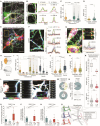This is a preprint.
Intercellular communication in the brain via dendritic nanotubular network
- PMID: 40475405
- PMCID: PMC12140006
- DOI: 10.1101/2025.05.20.655147
Intercellular communication in the brain via dendritic nanotubular network
Update in
-
Intercellular communication in the brain through a dendritic nanotubular network.Science. 2025 Oct 2;390(6768):eadr7403. doi: 10.1126/science.adr7403. Epub 2025 Oct 2. Science. 2025. PMID: 41037599
Abstract
Recent studies have identified intercellular networks for material exchange by bridge-like nanotubular structures, yet their existence in neurons remains unexplored within the brain. Here, we identified long, thin dendritic filopodia that establish direct dendrite-to-dendrite contacts, forming dendritic nanotubes (DNTs) in mammalian brains. Using super-resolution microscopy, we characterized their unique molecular composition and dynamics in dissociated neurons, enabling Ca2+ propagation over distances. Utilizing imaging and machine-learning-based analysis, we confirmed the in situ presence of DNTs connecting dendrites to other dendrites whose anatomical features are distinguished from synaptic dendritic spines. DNTs mediate the active transport of small molecules or human amyloid-beta (Aβ), implicating the role of DNT network in AD pathology. Notably, DNT levels increased prior to the onset of amyloid plaque deposits in the mPFC of APP/PS1 mice. Computational simulations predicted the progression of amyloidosis, providing insight into the mechanisms underlying neurodegeneration through these DNTs. This study unveils a previously unrecognized nanotubular network, highlighting another dimension of neuronal connectivity beyond synapses.
Conflict of interest statement
Competing interests The authors declare no competing interests.
Figures






References
-
- Ramírez-Weber F.-A., Kornberg T. B., Cytonemes: cellular processes that project to the principal signaling center in Drosophila imaginal discs. Cell 97, 599–607 (1999). - PubMed
-
- Rustom A., Saffrich R., Markovic I., Walther P., Gerdes H.-H., Nanotubular highways for intercellular organelle transport. Science 303, 1007–1010 (2004). - PubMed
-
- Abounit S., Zurzolo C., Wiring through tunneling nanotubes–from electrical signals to organelle transfer. Journal of cell science 125, 1089–1098 (2012). - PubMed
-
- Alarcon-Martinez L. et al. , Interpericyte tunnelling nanotubes regulate neurovascular coupling. Nature 585, 91–95 (2020). - PubMed
Publication types
Grants and funding
LinkOut - more resources
Full Text Sources
Miscellaneous
